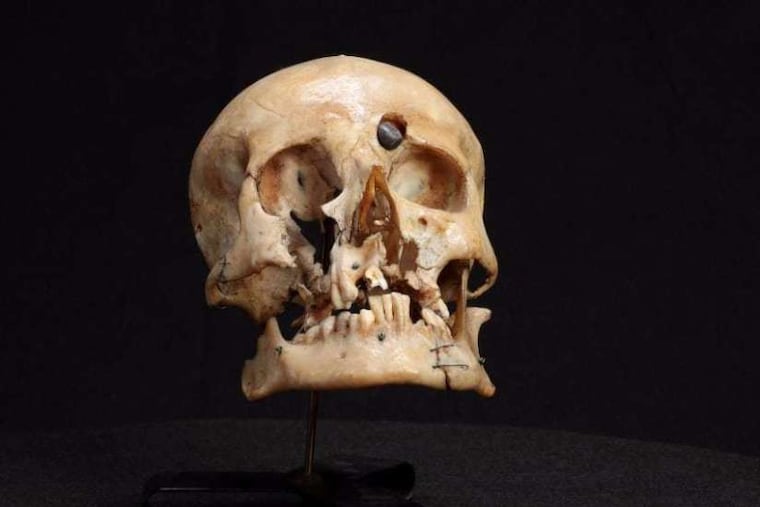Mutter Museum to return skull of Australian soldier killed in WWI
A article about the specimen's origins prompted calls for its return to Australia.

The skull that had been on display at the Mutter Museum of an Australian soldier who was killed in World War I will be returned to his nation's military, the museum announced Tuesday.
In Philadelphia, at a date to be set, the museum will present the skull, which still has a bullet lodged in it, to Brigadier S.L Gabriel, military attaché of the Australian Embassy in Washington. In a letter to the museum, Gabriel confirmed a finding by a British military forum that the skull was that of Pvt. Thomas Hurdis, of New South Wales.
Hurdis, who was 27, was wounded Sept. 28, 1917, during the Battle of Polygon Wood near Ypres, Belgium. He died five days later.
The U.S. Army surgeon who treated him was W.T. Shoemaker, a Philadelphia ophthalmologist.
Initial reports had indicated that Shoemaker had donated the skull to the Mutter. The museum, however, said Tuesday that the British government, through the British Medical Services, gave the skull to the museum as part of a collection intended for study by military doctors conducting reconstructive surgery on soldiers.
Gabriel noted that the museum's possession of the skull was "entirely consistent with the applicable laws and protocols."
The skull's existence and the nationality of its owner were not widely known until an article appeared Sept. 25 in the Guardian, prompting some Australian politicians to call for its return.
The Mutter said the Australian army first contacted the museum about the skull in August.
"I very much appreciate [the museum's] understanding and respect for the nature of this request and the considerable detail [they] have provided … including how this has directly contributed to the development of military medicine capabilities," Gabriel said in his letter. "The repatriation and interment of Private Hurdis' skull is consistent with our ongoing efforts to recover, identify and formally inter human remains of our fallen from all conflicts."
Robert Hicks, director of the Mütter Museum and the Historical Medical Library of the College of Physicians of Philadelphia, said in a statement: "We can appreciate the position of, and are sympathetic to the mission of the Australian Army. The recovery of remains of soldiers who were lost in combat or died as prisoners of war is vital work."
"The Mütter Museum observes a high standard of care and respect regarding human remains, and our observances of relevant laws and protocols is consistent with best practice in United States museums," he said.
The U.S. and British armies have long authorized the collection of specimens without permission from wounded or dead soldiers for medical education as long as the individuals from whom they were taken were not identified in relation to the specimens.
A current exhibit at the Mutter focuses on Civil War medicine and includes specimens collected during the war and provided to the museum by the U.S. Army.
Members of a British military forum started investigating the origin of the skull after the Guardian article appeared.
Based on when the soldier was shot and when he died as well as the nature of his wounds and location of the hospital where Shoemaker was stationed at the time, the forum members said they believed the skull was that of Hurdis, whose grave is near where the hospital was in France.
"I'm really pleased to hear that, on the centenary of his death, Australian authorities have confirmed that the skull is that of Thomas Hurdis and that the museum is to return it," said John Hartley, a military historian and member of the forum. "The right thing has been done here and we can look forward to Thomas' skull being buried, along with the rest of his remains, at the Commonwealth War Graves cemetery in Le Treport, France. I hope to pay my respects to this brave man during a battlefields trip next spring."